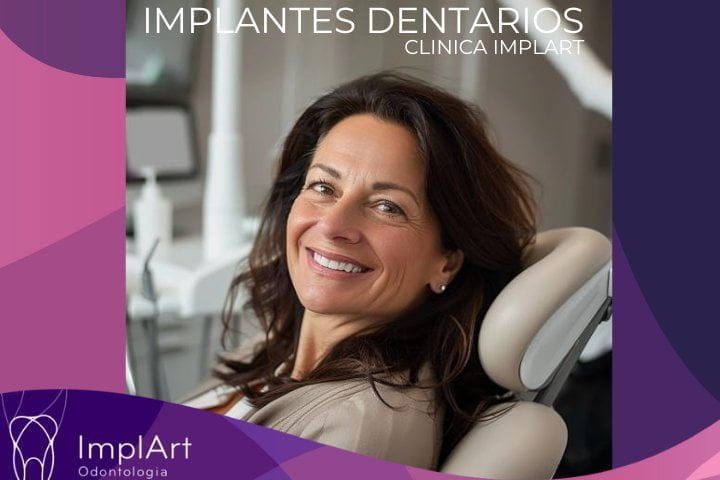
Dental implants: Learn all about dental implants in this guide
Dental implants have revolutionized modern dentistry, offering effective and long-lasting solutions for replacing missing teeth. If you’re considering this option or simply want to better understand how the process works, this guide is for you. Here, we’ll explore everything you need to know about dental implants: from the benefits and types available to the surgical procedure and post-operative care. Get ready to discover how to regain the functionality and aesthetics of your smile with confidence.
What dental implants are used for
The state of our smile plays a fundamental role in our general well-being. We express many of our emotions when we smile. In addition, when we interact with others, we are always showing our teeth, this is inevitable and part of human nature.
The good news is that nowadays the problem of missing teeth is becoming easier and easier to solve with dental implants. This modern treatment is constantly evolving, with versions of dental implants that adapt to different situations: fast implants, short implants, narrow implants, modern implants, nanotechnology implants, total implants, etc.
In this article we’ve prepared a complete guide to everything about implants, so you can find out tips, benefits, indications, tips and much more about dental implants. Follow along!
What is a dental implant?
Dental implants can currently be made of two materials: titanium or zirconia, which act as artificial roots. In this way, they can be inserted into both the maxillary and mandibular bones to replace missing or compromised teeth.
Basically, a dental implant replaces the root of a tooth, giving stability to the prosthesis or dental crown. After the implant placement surgery, a period called osseointegration begins. This is precisely the moment when the dental implant gains stability with the bone, which will certainly allow the implant to withstand the stresses and pressures of the chewing process.
Undeniably, dental implants are a revolutionary solution that allows patients to replace missing teeth with stable, long-lasting and effective solutions.
Certainly, the wide range of dental implant options makes it possible to reach an increasing number of patients. For example, even patients with poor bone structure can now have dental implants in most cases. In this way, more and more patients are able to experience the benefits of treatment, improving their quality of life, self-esteem and confidence to smile.
Extraction and dental implant in the same surgery
In the video below, our clinical director, Dr. Roberto Markarian, explains how the option of treatment with extraction and dental implant in the same surgery works:
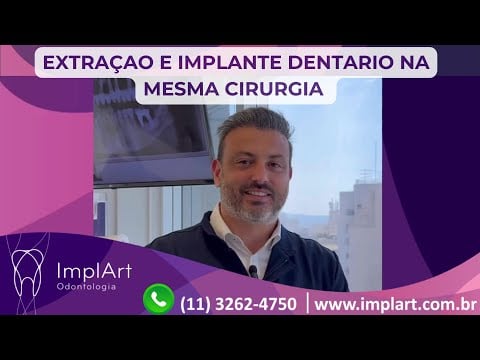
What is the difference between an implant and a pivot?
The dental implant and the pivot have significant differences, although in both treatments the intention is to recover a damaged tooth. While the implant involves a surgical procedure, the pivot is a prosthetic procedure. The definition of the type of treatment must be carried out by the dental surgeon, and will certainly depend on the degree of damage to the tooth.
The pivot is a dental prosthesis that requires the installation of an intraradicular core inside its root. In other words, in this treatment option the tooth root is maintained after root canal treatment and a core is inserted to structure the tooth and support the dental crown.
Implants, on the other hand, are used when the tooth can no longer be preserved with conventional treatments and tooth extraction is necessary.
As mentioned above, the definition of the treatment will depend on an individual analysis by the specialist, who will also assess the desired aesthetic objectives.
What is the difference between implants and dentures?
Many patients confuse dental implants with dentures. It’s important to mention that when we’re talking about dental implants, we’re always talking about a surgical procedure. When we talk about rehabilitation with implants, the dental prosthesis or dental crown refers to the “tooth” supported on the dental implant.
In the past, to replace a missing tooth, the solution used to be a 3-part fixed prosthesis. This meant that the teeth next to the lost tooth had to be worn down in order to support the prosthesis. Today, however, modern dental implants make it possible to replace a missing tooth without affecting the teeth next to it.
In the video below you can see the differences between fixed prostheses and dental implants:
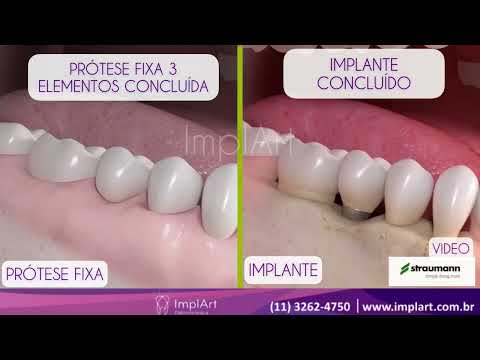
Read more: New types of dental implants
When we talk about removable dental prostheses, we are referring to dentures, which are the old removable prostheses. Of course, dentures are being used less and less, being replaced by the modern protocol prosthesis, which is a prosthesis fixed on 4 to 6 implants. The most modern material for protocol prostheses is Translucent Zirconia.
Types of Dental Implants: Types of Dental Implants
See below for the types of dental implant:
- INDIVIDUAL DENTAL IMPLANT, UNITARY IMPLANT or SINGLE-TOOTH DENTAL IMPLANT
The first type of implant is the single tooth implant. This solution is ideal when the patient loses a single tooth and needs to replace it. The procedure consists of inserting an individual titanium or zirconia dental implant into the bone. It can be performed in either the maxillary or mandibular bone. After the implant has healed, a dental crown is made, which, if made of zirconia, will be very natural and similar to natural teeth.
Watch the video below about individual dental implants:
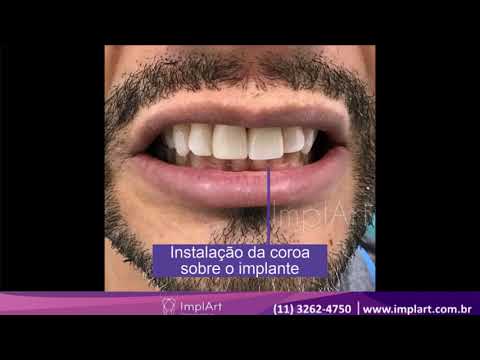
- TOTAL IMPLANT WITH FULL ARCH FIXED PROSTHESIS
The second most important type is treatment with a total implant and a protocol prosthesis. This treatment is recommended for patients who have lost all the teeth in a complete arch. This treatment can be carried out on both the upper and lower arches. This type of treatment involves six to four implants on which the protocol prosthesis will be fixed. This treatment certainly makes the patient feel comfortable, both when smiling and when eating. See how the full implant and protocol prosthesis treatment works in the video below:
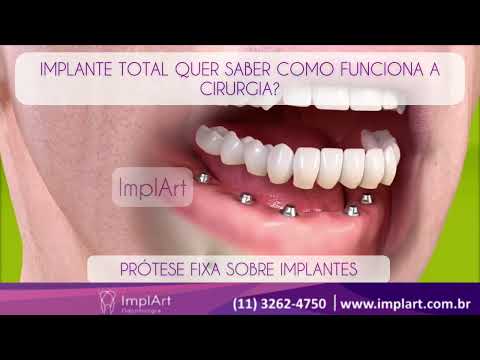
- DENTAL IMPLANT TWO BY THREE (2 x 3)
This treatment option can be used in cases where there are some bone limitations, or when patients need to reduce treatment costs. Therefore, instead of performing single tooth implants, 2 implants are performed which will support a prosthesis with 3 crowns. In this situation, the patient has a fixed bridge over the implants, rather than individual teeth. It is therefore not possible to floss between the teeth, for example, as is possible with the conventional single implant technique. Therefore, if the conditions are right, opt for a single implant if you are looking for a result similar to natural teeth.
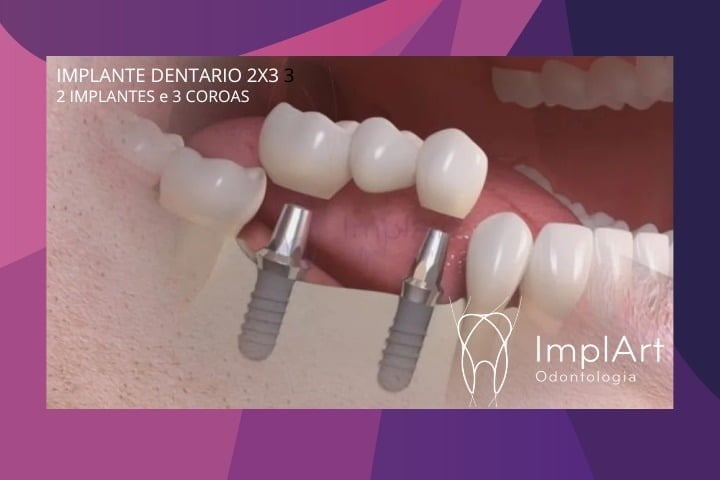
- ZYGOMATIC IMPLANT
Treatment with zygomatic implants is used in some cases where there is extreme bone loss. They are anchored in the zygomatic bone (cheekbone) and are used to support fixed prostheses. The truth is that they are being used less and less these days, as there are less invasive treatment options. Certainly one of them is bone grafting in patients with bone loss, followed by dental implants.
- IMMEDIATE LOADING IMPLANTS
Immediate loading dental implants is a technique in which the procedure of placing a dental implant and a fixed prosthesis is carried out more quickly. Immediate loading means placing a prosthesis – usually temporary – fixed to the implants immediately after surgery. Of course, the viability of immediate loading implants depends on a few prerequisites. These start with checking all the preoperative X-rays and CT scans. In addition, there are factors related to the surgery itself with conditions that can only be attested to at the time of implant insertion.
- SHORT IMPLANTS
The new short dental implants are indicated for patients who, for whatever reason, have limited bone availability. They are therefore very versatile, increasing treatment predictability and the chances of acceptance in patients with compromised bone availability. Often, the need for bone grafting to increase the vertical dimension can be dispensed with, bringing greater peace of mind and speed to the treatment.
Read also: Short implants: Solutions for those with little bone!
- ZIRCONIA IMPLANTS
Zirconia implants are metal-free, made of highly resistant ceramic and therefore have an ivory hue. They are an excellent option for those patients who have very thin or atrophied gums. This is especially important for front teeth. They are also an excellent option, especially when these conditions occur in the anterior region (the most visible part of the arch). It is therefore an excellent option for those looking for a dental implant treatment with the best aesthetics available. Watch the video below showing the zirconia implant surgery:
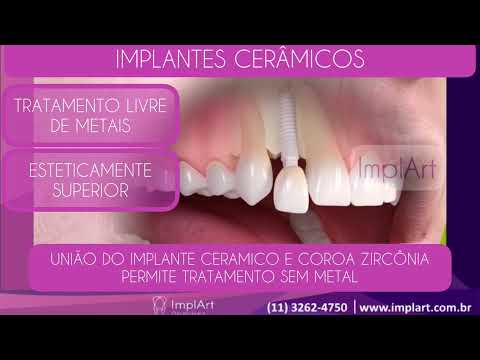
- NANOTECHNOLOGY IMPLANTS
Modern nanotechnology implants present a revolution in dental implant production because they add nanometric particles to the surface of the implant. These particles are prepared to perform healing functions as soon as they come into contact with human tissue. In this way, these nanometric particles act as catalysts or coadjuvants to stimulate the process of osseointegration. Therefore, by using these implants we have a reduced healing time and a greater chance of success.
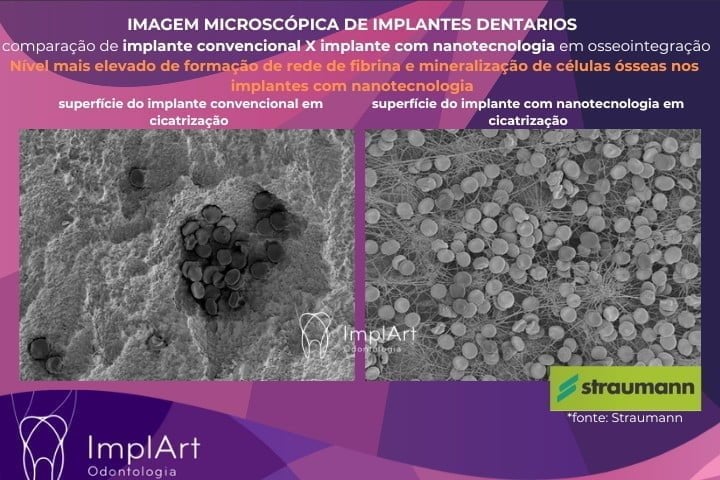
Read more: Implants with nanotechnology: New options for those looking for the latest implants!
Check out the advantages of dental implants
Certainly the main advantages of dental implants are that they unite two important points in anyone’s smile: aesthetics and chewing function. In these respects, dental implants are unbeatable and are undoubtedly the best alternative for replacing one or more missing teeth. If the tooth loss is frontal, the front tooth implant can provide natural results, bringing comfort and security to the patient’s smile. Check out the video below showing the real results of a front tooth implant treatment:
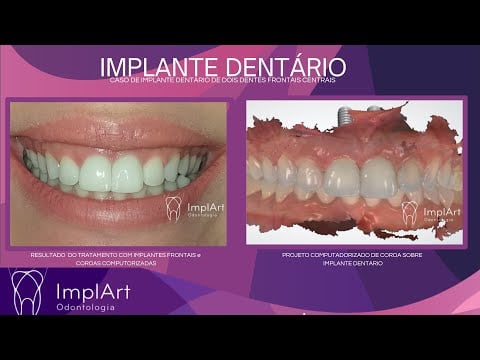
Undeniably, the implant, by allowing the dental arch to be rebalanced, brings direct benefits to the patient through comfort when eating and confidence when smiling. All these factors provide a direct increase in the patient’s quality of life and well-being
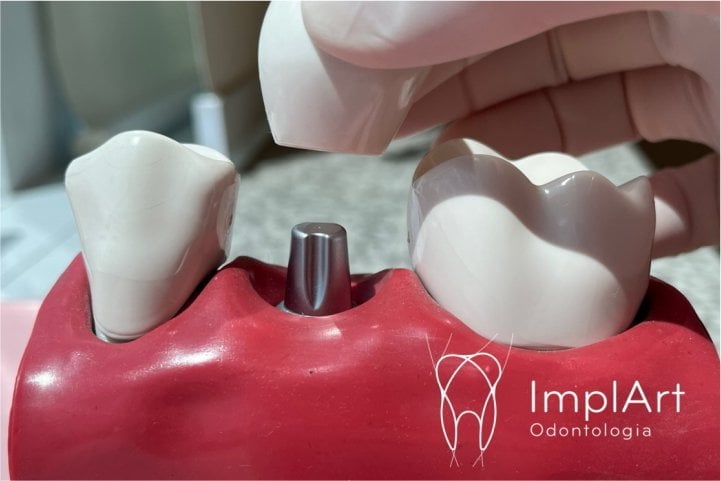
Here are some of the main advantages of implants:
- Quick replacement of a lost tooth
- Restoring aesthetics: Dental implants are designed to look and function like natural teeth, making them the best way to replicate them. That’s why they allow you to regain the aesthetics of your smile.
- Maintaining long-term results: Dental implants are effective structures, capable of lasting for many years and enabling long-term results.
- Balanced chewing: The dental implant is a structure capable of withstanding the intense chewing efforts to which the teeth are subjected. Therefore, they allow the patient to eat with great comfort and stability, even more so when compared to old dentures.
- Bone maintenance: The dental implant is able to stabilize the natural bone absorption that occurs in the area that has suffered tooth loss. In this way, the bone structure is maintained and there is no impact on neighboring teeth. See below for a video showing the consequences of missing teeth that are not replaced by implants.
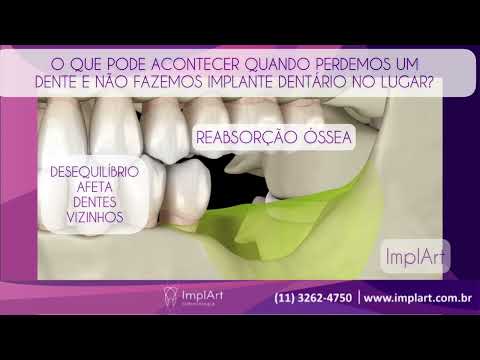
How are dental implants performed?
Dental implant surgery can be carried out in the office or in hospital. The implant can be installed under local anesthesia or intravenous sedation. Implant installation surgery is usually quick and can last between 15 minutes and 1.5 hours, depending on the number of implants and the patient’s bone situation.
Dental implants are designed to adequately replace the root of a lost tooth and can be made of either titanium or zirconia. Below is a photo of the zirconia dental implant surgery.
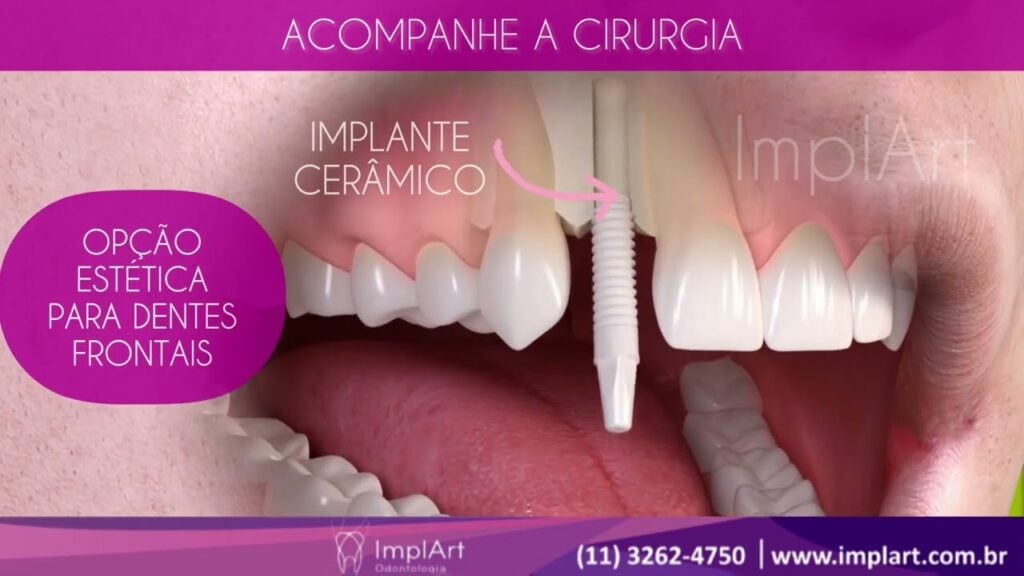
In most cases, during the implant’s osseointegration period, the patient has a temporary crown installed. After the implant has healed, the definitive crown can be made. There are currently several types of dental crowns, including the modern CAD/CAM Pure Zirconia Crown and CAD/CAM Pure Porcelain Crown. These crowns are made using modern 3D scanning and printing systems, which allow the patient’s smile to be designed using computer graphics. In this way, the aesthetic results are enhanced and the crowns look even more like natural teeth.
CONFIRMS THE STEP BY STEP OF THE DENTAL IMPLANT:
- INITIAL ASSESSMENT AND PLANNING FOR IMPLANTS
The purpose of the evaluation appointment is to assess the patient’s case, identifying the patient’s needs and expectations. It is at this stage that the implant dentist, Dr. Roberto Markarian, is able to assess the best treatment for the patient, as well as indicating the types of implants and dental prosthesis options recommended for the patient. Of course, each case is thoroughly assessed and each plan is personalized.
See in the video below how the initial consultation at the ImplArt Clinic works:
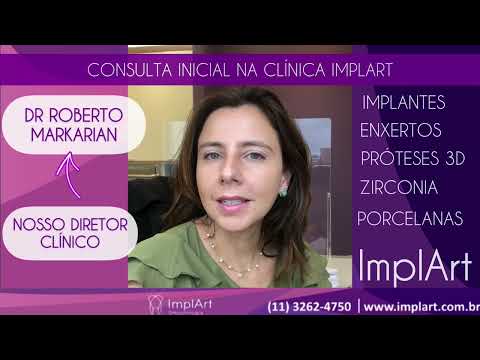
In addition to the clinical assessment, specific tests are requested to analyze the patient’s oral structure, anatomy and bone structure. These examinations are certainly a fundamental part of careful case planning.
Today, it is possible to have modern dental implant examinations carried out directly at the ImplArt Clinic Radiology Center:
- Panoramic radiography;
- Periapical radiography;
- CT scans
In addition to the following procedures for treatment planning:
- 3D intraoral scanner
- Dental Photography;
In general, dental implant surgery is very similar to tooth extraction surgery. It usually takes place in a dental office, under local anesthesia, or with the use of conscious sedation performed by an anesthesiologist from the Clinic’s team. The use of sedation is a treatment option for those patients who are afraid of dental procedures, or even for those who prefer the comfort of the procedure. See how sedation works for dental implants in the video below:
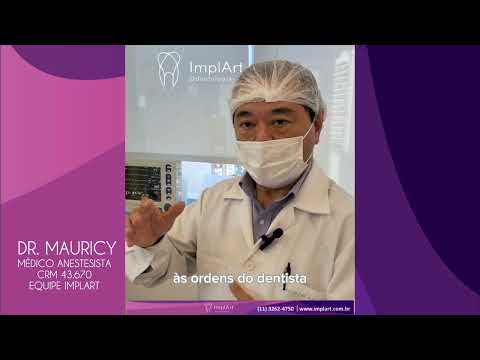
In the first surgical stage, the implant is installed in the bone. Using specific equipment, the implant dentist positions the implant in the area of tooth loss. In many cases it is possible to perform tooth extraction and implantation in the same surgery. Of course, the surgery is carefully planned beforehand, based on the patient’s examinations. In this way, the implant dentist is able to choose the implant size, defining the most appropriate height and width.
Immediately after the implant is placed, a kind of cover is put in place to protect the implant while it awaits osseointegration. This process is common to all types of implants.
Immediately after surgery, it is recommended that the patient rests for the rest of the day. The usual certificates for implants are for two or three days, which is the period of greatest care, with ice applied to the area. As the days go by, activities are slowly released, and after 7 days the patient can resume normal activities.
What’s more, in the vast majority of cases, the superficial healing of the gums is fairly rapid. Within a week to 10 days, the patient returns to the clinic for follow-up and removal of stitches, when the surgery is performed conventionally. In cases of surgery without cuts, with a surgical guide, there are no stitches to be removed.
Read more: How many days to rest after dental implants?
- OSSEOINTEGRATION
In this phase of treatment, we basically wait for the implant to heal. Depending on the type of implant chosen, this period can take between one and six months, and certainly in the case of simultaneous bone grafts, this period can be increased.
It’s worth noting that this stage is extremely important for the success of the treatment, so following the recommendations is essential. Hygiene guidelines must be followed, as well as avoiding smoking, which can compromise implant healing. In fact, the lack of proper hygiene, as well as smoking, be it electronic cigarettes, conventional cigarettes or cannabis, are factors that impair implant healing.
- DENTAL IMPLANT REOPENING
This is the second stage of surgery, when the dental implant specialist reopens the gums to remove the protective cap. After this, the implant healer is installed, which is a device that prepares the gum tissue to receive the prosthesis and serves to make it heal properly, leaving only the access to the implant exposed.
- MAKING THE PROSTHESIS
The last stage of treatment is when the implant has healed and the prosthesis or dental crown is made in the chosen material: translucent zirconia, pure porcelain, zirconia + porcelain or metal-ceramic. If the patient opts for modern materials such as CAD/CAM Pure Zirconia and CAD/CAM Pure Porcelain, the crown will only be made using a 3D intraoral scanner, without the need for the old mass molding. Once this stage has been completed, the treatment is finished and the patient can enjoy all the benefits of their treatment.
Read also: What is dental implant surgery like? Learn More About Implants
Indications for Dental Implants: Who Can Get an Implant?
Every patient who is a candidate to receive a dental implant must have their health assessed through anamnesis and general health assessment, as well as clinical analysis. The result is that the vast majority of people meet the necessary conditions to undergo the procedure. However, there are some rare exceptions. Let’s take a look below:
- patients with uncontrolled health problems: such as uncontrolled diabetes, for example. It is worth clarifying that even if you have diabetes, if it is controlled, you are a candidate to receive implants
- pregnant patients
- children and adolescents, as they are still growing;
How many dental implants are needed for the protocol prosthesis?
The number of dental implants required for treatment will certainly depend on the treatment objectives and the patient’s initial situation. If the treatment involves total implants and a protocol prosthesis, 4 to 6 implantswill be used. The number of implants will certainly be defined by the implant dentist based on an analysis of the patient’s bone condition and the type of prosthesis to be used
By analyzing panoramic X-rays and CT scans, the implant dentist is able to determine the number of implants needed to ensure better stability of the protocol prosthesis. In addition, if the patient opts for a resin protocol, 4 dental implants are usually used. If the treatment involves a total prosthesis in metal-ceramic or zirconia, up to 6 dental implants can be used.
When many teeth are lost, are the implants done individually, one by one?
In general, when patients have lost many teeth, they opt for a treatment called total implant and prosthesis protocol. This treatment guarantees stability in chewing and oral aesthetics. In some specific cases it is possible to perform individual implants one by one. However, the patient must meet a number of prerequisites, such as abundant bone structure.
Still have questions about implants? Visit this page for more information: Implant all individual teeth with confidence
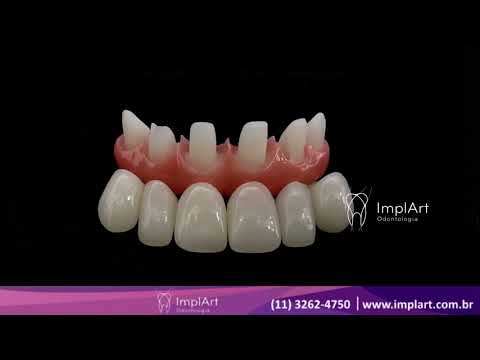
Are there any contraindications to dental implants?
As we saw earlier, the benefits of dental implant treatment are numerous! However, it is important to know that there are situations that can jeopardize the success of the treatment. For example, poor hygiene and smoking can compromise the healing process of implants.
Bone Condition
Nowadays, with advances in bone grafting techniques, the vast majority of patients can have dental implants. In fact, it is very rare for a patient not to be able to do so. In cases of bone loss, bone grafting is essential for the success of the procedure. So nowadays, thin bone is no longer an impediment to implants.
Poor oral hygiene – lack of hygiene after implants
Some patients start implant treatment as a result of tooth loss aggravated by periodontal disease. It is important to note that prophylaxis is essential for monitoring and combating peridontal disease. It also makes it possible to identify tooth decay and eliminate tartar. Hygienization is certainly aimed at preserving the patient’s oral health, including that of their implants. Lack of cleaning can affect the health of dental implants and lead to peri-implantitis, an infection of the implant.
Read more about peri-implantitis: Peri-implantitis: the dreaded dental implant infection
Learn more about cleaning: The importance of professional cleaning for maintaining dental implants, dentures and oral health
Smoking patients – Smoking and implants
Dental surgeons are unanimous in their opinion that smoking is one of the most damaging habits for oral health and the health of your dental implants. This applies to almost all types of smoking: cigarettes, cigars, e-cigarettes, cannabis, straw cigarettes, pipes, among others. Smoking certainly poses risks to implant treatment, increasing the likelihood of failure. Therefore, to increase the chances of success with implants, this is the ideal time to create new healthy habits!
Read more: Smoking patients: what are the consequences of electronic or conventional cigarettes on oral health?

Patient’s general state of health
Being in good health is certainly one of the starting points for having a surgical procedure. Therefore, patients should not neglect their general health when considering dental implants. Today, medicine is preventive, and dentistry goes hand in hand.
That’s why an annual check-up is essential to identify any disorders that could jeopardize the success of your implant treatment. Heart disease, diabetes, coagulation problems and hormonal disorders are among the points that deserve attention for patients who are going to have dental implant surgery. In this case, the dental surgeon and the doctor responsible for the patient’s health exchange information to define the best alternatives for implant surgery.
Can implants be done at any age?
an adult in good health can have a dental implant at any age. The limiting factor is certainly not the patient’s age, but their general health. Implants are not recommended for children and adolescents because their bone structure is not yet fully formed. Therefore, in cases of missing teeth due to agenesis, for example, you should wait until the minimum age for dental implants.
Can dental implants be done during pregnancy?
Normally, when pregnant, the patient is told by her obstetrician to avoid surgical procedures at the dentist precisely because of the anesthesia she has to undergo. Of course, this can pose risks to the baby’s health.
Therefore, if the procedure is not an emergency, the patient will be advised to wait until the end of her pregnancy before having the implant. However, if the procedure is urgent, it should only be carried out with the obstetrician’s permission.
Alternatives to dental implants
Don’t want to get dental implants or can’t and are looking for an alternative? Oral rehabilitation with dental implants can restore your smile by giving you back one or more missing teeth. It is certainly a very safe procedure. However, this procedure may not be suitable for all cases. For these situations, the patient can have:
- Fixed dental prosthesis on teeth
- Adhesive resin dentures
- Dental prosthesis with tooth suspended without support (cantilever)
- Removable partial dentures
It should be noted that dental implants are the most comfortable and efficient solution for replacing a missing tooth, and that the patient should be aware of the pros and cons before deciding on a type of treatment. But don’t worry, your dental surgeon will be there to help you make this decision with all the information you need.
If you have any doubts about the types of dental prostheses and want to know more, go here: Alternative to dental implants – Types of dentures
How Long Does Dental Implant Treatment Last?
The duration of dental implant treatment will depend on the patient’s bone situation. Thus, if the patient needs bone grafting, the treatment period can be extended. In addition, the total treatment time will also be determined by the type of dental implant chosen. Nowadays, there are fast-healing implants that can heal in 1 month under ideal conditions. So if you want to complete your treatment more quickly, opt for implants with nanotechnology!
Read more about rapid implants: Rapid dental implant treatment with Slactive implant + pure zirconia or pure porcelain prosthesis
What are the possible risks and complications of dental implants?
Dental implants are certainly a very safe and effective dental procedure! However, as with any health procedure, there are always risks, however minimal. Find out what they are:
- Excessive bleeding: In some situations, there may be more obvious bleeding in the implant surgery area. Normally, if this happens, the implant dentist acts to stop the bleeding. However, for patients who use anticoagulants, it is always advisable to stop taking them a few days beforehand.
- Infection: In fections are very rare in the dental implant procedure, as the patient is given antibiotics to take before and after surgery
- Poor osseointegration: In some cases, the implant may not heal as expected. In addition, smoking and poor hygiene compromise implant healing.
- Incorrect implant positioning: If the implant dentist is inexperienced, there may be aesthetic or functional problems due to incorrect implant positioning. Is
It’s worth noting that the chances of a successful dental implant are very high. The procedure is therefore very safe and the chances of complications are minimal!
Care immediately after placing a dental implant
During the first two days, which are the immediate post-dental implant period, it is recommended to remain at rest. In addition, we can summarize the recommendations of:
- Apply ice to the face to prevent swelling
- Food / what to eat? Eat cold or icy foods. For example: ice cream, açaí, gelatine, juices, vitamins, soups. We can also recommend that these foods do not contain grains or particles. Also prefer soft or pasty foods. Above all, do not chew hard foods.
- Do not eat foods with irritating potential (spicy, acidic, salty, fizzy or hot).
- Avoid physical exertion
- No mouthwashes (even for 7 days)
- Sanitize the area with a cotton swab moistened with an antiseptic solution (Periogard, Listerine, Plax).
- Normal brushing of other teeth
- Wear prostheses or braces for as short a time as possible
- Take medication as directed by the dentist
- Avoid the sun and hot environments
In addition to this care, follow the specific instructions provided by your dental surgeon, as each case may have individual needs. As the osseointegration process takes between 1 and 6 months, it is essential that the patient follows the specific care instructions for each stage of the process. This will certainly enable them to obtain the best results and avoid any complications during treatment.
Post-operative implant care
The intensity and duration of recovery after dental implant surgery obviously depends on the extent of the procedure, the technique used and the type of implant used. In general, the post-operative period is fairly uneventful. The patient should follow the guidelines and take the recommended medication: antibiotics, anti-inflammatories and analgesics.
Total rest period (rest days after dental implant):
- Light activities (7 to 10 days): Rest is recommended for light activities during the first week, which can be extended to 10 days.
- Gradual return to normal activities (up to 3 weeks): The patient is instructed to gradually return to normal activities, which may take up to 3 weeks.
Read more: How many days to rest after dental implants?
Implant cost. How Much Do Dental Implants Cost?
First of all, it’s important to bear in mind that when it comes to quality dental treatment, the price of a dental implant can’ t always be the deciding factor, but rather the quality of the treatment. For this reason, it is essential that the patient assesses the technical knowledge of the professionals, their qualifications, as well as their years of practice and the type of treatment proposed.
There are certainly several options for materials and techniques that influence the composition of a budget. Already at the initial consultation, patients can find out how much their treatment will cost. If the patient is far away, in another state, city or abroad, it is possible to plan your dental implant surgery remotely, with an online consultation with Dr. Roberto Markarian, director of the ImplArt Clinic.

At the ImplArt Dental Clinic, the patient will also be evaluated by Dr. Roberto Markarian, an implant dentist.
Dr. Roberto Markarian holds important academic degrees such as a Master’s, Doctorate and Specialist in Prosthodontics and Implantology. After the evaluation, with a definition of the type of implant and prosthesis chosen, it will be possible to draw up a complete budget for the treatment.
See more: Dental Implants SP – Check out How Much a Dental Implant Costs!
Myths and truths about dental implants
After all, do dental implants hurt? This is certainly the biggest fear of anyone who needs a dental implant. However, we’re going to show you that nowadays, modern resources make the surgery more pleasant, with a more relaxed post-operative period! In addition, we’ll talk a little about the types of prostheses and the myths that exist.
Find out if the implant causes any pain and learn some myths and truths about the procedure:
1. Do porcelain prostheses on both arches make noise?
Myth! Total implant treatment, called a protocol prosthesis, is characterized by the creation of dental implants that will receive a fixed prosthesis resting on them. There is a myth that porcelain prostheses on implants in both arches could generate noise when they collide during chewing or speaking. It’s worth clarifying that implant-supported prostheses, when properly adjusted, will definitely not make noise when they touch each other during speech or chewing.
Read more: Do porcelain dentures on both arches make noise? Myth!
2. Are porcelain implants heavy?
One misconception that some people have about dental implant prostheses is that porcelain or ceramic prostheses can be heavy. Dental implants are designed to withstand the very high forces produced by chewing, so there’s nothing to worry about. The weight of the dental prosthesis will be irrelevant compared to the strength of the implant. The dental implant that will receive the fixed prosthesis will be ready to receive any type of dental prosthesis you choose.
Therefore, if you can, opt for modern Translucent Zirconia or Porcelain prostheses– the results are worth it. These materials certainly offer high durability, as well as superior aesthetic results compared to resin prostheses, which are made from plastic material.
Read more: Let’s dispel the myth of heavy porcelain prostheses!
3. I no longer need to clean after having implants
Myth: Even those with dental implants should not neglect their oral hygiene. Regular cleaning aims to prevent the dreaded peri-implantitis, which can lead to the loss of the dental implant. So keep up your brushing and flossing at home, and go to the dentist every 6 months for a prophylaxis!
4. I can chew normally after dental implant surgery
True. Although care must be taken during the first few days, within 7 days of the surgery, the gums have usually healed and the patient is able to eat normally again. Of course, it is expected that throughout the process of osseointegration of the implants, the patient will have to follow specific precautions. However, once the implants have healed and the final prosthesis has been made, the patient will be able to chew and eat normally!
5. The body may not accept the implant and reject it
Myth: Dental implants are made of inert materials, and this applies to both titanium and zirconia implants. In cases where osseointegration does not occur as expected, the reasons should be investigated. It is worth noting that one of the main reasons is smoking and lack of post-surgical care, such as proper hygiene. It should be noted that patients who smoke greatly increase the chances of implant failure.
Do dental implants hurt?
Do dental implants hurt? Many people stop improving their smile believing that dental implant surgery is painful. The reality is that advances in techniques mean that dental implant surgeries today are less and less invasive, avoiding excessive tissue damage, pain and discomfort.
See also: Do implants hurt or not?
Dental implant surgery has become increasingly simple, and surgical techniques and prior planning, such as computerized tomography, for example, make the implant procedure much more predictable.
In addition, the surgery is always performed under local anesthesia to make it painless. Electronic anesthesia can also be used, with a feature that makes even the sting of anesthesia painless. Of course, the ImplArt Dental Clinic uses various techniques to reduce discomfort during surgery and make the recovery period more peaceful.
One of the techniques is that Clinica Dentaria ImplArt performs computer-guided dental implant surgery. This is undoubtedly an innovative technique that avoids unnecessary cuts and damage to bone and gum tissue
So if you’ve been putting off your implant surgery because you think dental implants hurt, you don’t have to worry about that! We’ll show you that Clinica ImplArt uses all the modern resources available to make your implant surgery go much more smoothly!
Dental Implant Results: Before and After
Dental implant treatment is always transformative. When patients seek dental implant treatment at the ImplArt Clinic, there is always a lot of anticipation to see the results. Of course, this is natural, as many patients report that they have waited for years to be able to have their treatment and therefore want to improve their smile quickly.
Here at the ImplArt Clinic, it is always a pleasure to accompany patients through this very important moment of transformation and regaining the self-esteem to smile.
Check out the dental implant testimonial below from our patient Sandro, who came straight from the United States to have his treatment at Clinica ImplArt. Watch:

Where to get a dental implant?
The ImplArt Clinic is located in Sao Paulo and welcomes patients from all over the world. ImplArt has been operating for over 15 years and has installed thousands of implants and solved hundreds of cosmetic dentistry cases. It is known for its modern dental treatments, and relies on the expertise of Dr. Roberto Markarian, a reference in Brazil for implants and computerized prostheses.
With all this know-how, the ImplArt Dental Clinic is able to offer the most modern techniques for individual dental implants, total implants and protocol prostheses. It also offers modern computer-generated contact lenses and 3D Pure Zirconia prostheses.
The smiles created by ImplArt are spread around the world, as it receives patients from all over the world for Day Clinic treatments: Japan, the United States, Canada, Switzerland, Portugal, Spain, the United Kingdom, Italy, Australia, the Netherlands, Germany, Angola and others! The high quality of ImplArt’s treatments makes the clinic an international standard treatment center, in line with the high demands of world standards.
The ImplArt Dental Clinic has been rated the best dental implant clinic in Brazil, coming first in the GCR world ranking. According to the Global Clinic Rating, this ranking was secured above all by ImplArt’s expertise in Digital Dentistry, Modern Structure and Patient Satisfaction.
Read more: Where to get a dental implant in Sao Paulo?
ImplArt has a team specialized in dental implants, made up of implant dentists, prosthodontists, endodontists, among other specialties! Schedule your appointment at the ImplArt Dental Clinicnow! If you’re looking for technology and the best results for your dental implant treatment, the ImpArt Clinic is the right place for you!
Find out more about treatments at Clinica ImplArt
To find out more about the treatments at Clinica Dentaria ImplArt, check out the images of our treatments on Instagram https://www.instagram.com/clinicaimplart/.
Our videos on Youtube: https://www.youtube.com/@ImplArtImplanteseestetica
See our Pinterest page: https://br.pinterest.com/implante/
To see our photo gallery of our treatments, click here!
Contact us by WhatsApp (11) 3262-4750
Dr. Roberto Markarian, implant dentist
Text written by DR. ROBERTO MARKARIAN – CRO-SP 73.583
Founder and Director of the ImplArt Dental Clinic – Dr. Roberto’s Linkedin profile
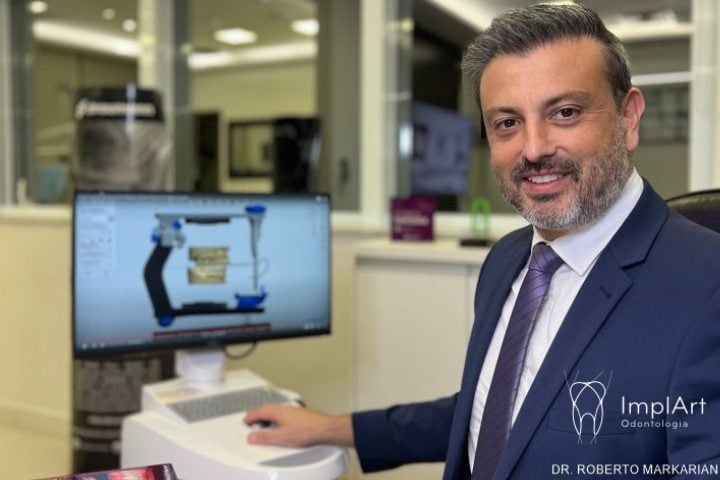
Dr. Roberto Markarian is a reference in dental implants and computerized dental prostheses in Brazil. As well as having more than 10,000 implants installed, he is a researcher and produces knowledge that is published worldwide in renowned scientific journals in the field of dentistry. He is responsible for promoting knowledge and high technology applied in all the treatments offered by the ImplArt Clinic.
- Post-Doctorate in Implant Dentistry – Univ SL Mandic (Campinas-SP) – 2020
- PhD in Implant Dentistry – Doctor of Implant Dentistry, Univ SL Mandic – 2017
- Dr. Roberto Markarian Specialist in Dental Implants at USP (Implant Dentist) – 2008
- Specialist in Prosthodontics (Prosthodontist ) by the CFO – 2006
- Master in Prosthodontics, USP – 2005
- Graduated as a Dental Surgeon from USP (São Paulo) – 2001
- Member of the Clinical Staff of Hospital Alemão Oswaldo Cruz
schedule your appointment at the implart clinic by phone or whatsapp
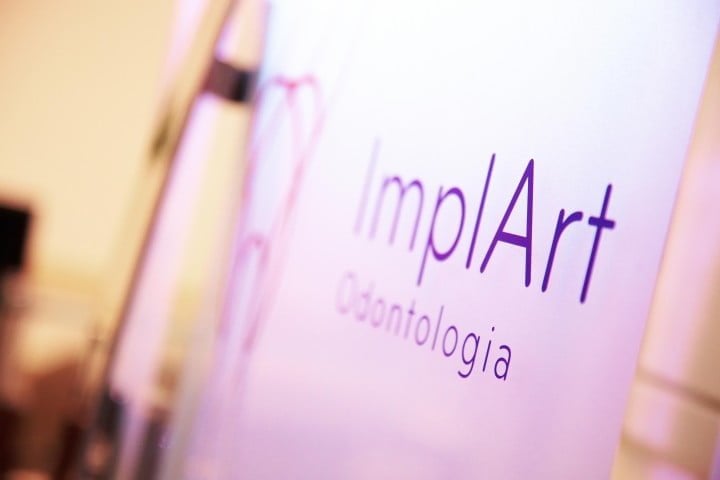
📲(11) 3262-4750
📲WhatsApp(11) 3262-4750

Leave a Reply